 |
The Tale of Charles Gough and his Faithful Dog Foxie |
 |
 |
8th July 2017 |
 |
|
Just over a month ago I was asked by my good friend and Lakeland writer Ron Black to plan a walk based on the tragic circumstances around the death of Charles Gough who in Spring 1805 lost his life after falling from Striding Edge. Anyone familiar to Helvellyn and indeed Striding Edge would have walked past the Gough Memorial Monument at the top of Striding Edge numerous times but how many have actually stopped to read the Memorial which quotes a passage from William Wordsworth poem Fidelity.
The Gough Memorial is a hundred and twenty seven years old after being erected in 1891 The words etched in stone are weathered and are difficult to read but in truth William Wordsworth was deeply moved by what had happened to Charles Gough and paid tribute to the love and devotion of Gough's pet dog Foxie in his poem.
Ron asked me to retrace Gough's route from Patterdale and to explore as safely as possible the area below Striding Edge where it was thought Charles Gough's body was found, in these modern times this I know; is an extremely sensitive area both physically and emotionally because lives are still lost to this day on Striding Edge, sensitivity is key. Ron was kind enough to send me two books "The Unfortunate Tourist of Helvellyn" and "Chronicles of Patterdale"
Ron is also good friends with the Lakeland legend Bill Birkett and I was urged to give Bill a phone call on the matter and having later being advised that Bill is a little hard of hearing these days Ron joked that he probably wouldn't hear the phone ring anyway, well I summoned the courage to ring Bill Birkett but sadly Bill never picked up which in a nice way I was kinda pleased about because I was as nervous as hell.
What follows is a modern personal account and findings into what happened to Charles Gough. |
|
| The Gough Memorial |
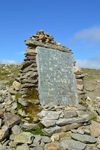 |
| Fidelity |
The Dog, which still was hovering nigh,
Repeating the same timid cry,
This Dog, had been through three months' space
A dweller in that savage place.
Yes, proof was plain that, since the day
When this ill-fated Traveller died,
The Dog had watched about the spot,
Or by his master's side:
How nourished here through such long time
He knows, who gave that love sublime;
And gave that strength of feeling, great
Above all human estimate! |
| William Wordsworth 1807 |
|
|
|
| |
 |
Overview |
 |
|
| Ascent: |
2,950 Feet 899 Metres |
| Wainwrights: |
Helvellyn |
| Weather: |
Warm, Dry and Sunny. Highs of 21°C Lows of 12°C |
| Parking: |
Roadside Parking, Patterdale |
| Area: |
Eastern |
| Miles: |
8.5 |
| Walking With: |
On My Own |
| Ordnance Survey: |
OL5 |
| Time Taken: |
5 Hours 20 Minutes |
| Route: |
Patterdale - Grisedale Lane - Grisedale Brow - Hole-in-the-Wall - Striding Edge - Helvellyn - Swirral Edge - Red Tarn - Hole-in-the-Wall - Patterdale |
|
| |
 |
Map and Photo Gallery |
 |
|
 |
Attachment
Edwin Landseer 1829 |
| Charles Gough faithful bitch Terrier "Foxie" was found alive three months after waiting at her masters side after Gough Fell from Striding Edge while on route to fish at Thirlmere. Gough died instantly from the fall here depicted in the painting "Attachment" by Edwin Landseer. |
 |
| Patterdale Village. |
The story behind Gough's death is still to this day locked in mystery and conspiracy but what is known was that Charles Gough the one time Quaker of Manchester was last seen on 18th April 1805 at noon when after refreshments at the Dobsons Inn at Patterdale he set off for Grasmere having already forwarded his boxes by carriage to fish at Thirlmere Lake. Aged just twenty one years Charles Gough was never seen alive again.
Gough was well known locally as an aspiring artist and poet and had frequented Ambleside and Patterdale years earlier and had grown fond of fishing during his frequent rambles in the wilds of Cumberland. Only days before Gough's ill-fated adventure over Helvellyn George Harrison, a mountain guide had seen Gough in Gowbray Park and asked "how come you be so early, the snow has not left the mountain and you can't get no fish for three weeks to come" to which Gough replied "I believe I am a little too soon, but I have prepared lodgings in the neighborhood and I will take my chance"
It is thought that Gough did attempt to secure a safe passage over Helvellyn by asking a guide to accompany him while at the Inn but was told that it was a general day of volunteers and there was no one to conduct him over the mountain.
Gough was subsequently advised to remain at the Inn as hail had fallen during the night and heavy fog was over the mountain. |
 |
| Birks seen with Thornhow End from the path below Glenamara Park. |
In the Georgian era of Lakeland around the time of Charles Gough people wouldn't have walked the fells as we know them today most of whom would have been scared off by stories of 4,000ft un-climbable mountains and inaccessible valleys. It was the later Victorians who brought their wealth to the Lake District most of whom would have been guided on ponies to the summits which is why to this day you can still see the metal rings attached to some stone shelters where they would tie up the pony, much like the metal ring attached to the Victorian stone shelter west of Scafell Pike summit.
Due to the remoteness of the District paths like this found in between Patterdale and Grisedale would have been scarce although my suspicion is this "low path" would have been used by farmers and shepherds at the time of Gough's death although the question still remains which route did Gough take into the Grisedale valley. |
 |
| Views towards Ullswater from Glenamara Park. |
| If Gough did pass this way he may well have walked passed this Oak tree as a sapling. |
 |
| Birkhouse Moor and Nethermost Pike from Grisedale Lane. |
The question of Gough's route onto Striding Edge still remains a mystery but it is certainly possible he took the low ridge after crossing Grisedale Beck known as Grisedale Brow (seen in shadow) to what is now known as Hole-in-the-Wall.
Other possibilities may include the Brownend Plantation and Little Cove route before continuing onto Birkhouse Moor then arriving at Hole-in-the-Wall, either route would of been much harder than we know today with hardly no path to follow. |
 |
| The view into the Grisedale Valley towards St Sunday Crag, Dollywagon Pike and Nethermost Pike. |
| |
 |
| The Grisdale Valley. |
With the exception of a few farm buildings the Grisedale valley remains untouched and is viewed just as Gough would have seen it had it not been for the fog which had descended over the mountain on that fateful day.
The question will always remain as to why Gough didn't use the Grisedale valley as a means of reaching Wythburn, possibly because this would be descent via Birk Side and Comb Gill would almost certainly descended him directly into what was then, the hamlet of Wythburn which was later flooded during the construction of the Thirlmere Reservoir in 1894.
Only Wythburn Church remains to remind us of what was Wythburn. |
 |
| The gradient eases slightly as Grisedale Brow is approached. |
| |
 |
| A close up of Nethermost Pike, Nethermost Cove, Nethermost Pike East Ridge, High Crag, The Tongue, Ruthwaite Cove and Dollywagon Pike. |
| |
 |
| Catstye Cam from Hole-in-the-Wall. |
| |
 |
| Views towards Striding Edge, Helvellyn, Helvellyn Lower Man, Swirral Edge and Catstye Cam. |
| Despite the lovely sunshine a fresh breeze has descended causing me to add my jacket, up ahead towards the left, Low Spying How and Striding Edge. I can see that there is already one chap along the edge seen in-between Low Spying How and High Spying How and with two walkers far behind me it should be relatively quiet on the edge this morning. |
 |
| Catstye Cam from Hole-in-the-Wall. |
| |
 |
| Both of these edges are great curiosities, and Striding Edge is the most remarkable. Adam Black "Guide to the Lakes" 1866 |
| |
 |
| Looking back on Birkhouse Moor as I pass over Bleaberry Crag towards Low Spying How. |
| |
 |
| Helvellyn and Striding Edge from the path towards High Spying How. |
| I can only imagine the terror that Charles Gough was now faced with in a time where maps were scarce and waterproof clothing hadn't been invented. Gough approached Striding Edge wearing a heavy cloak, waistcoat, stockings and boots with a wooden staff in one hand and his fishing rod in the other, all the while hail would have been falling below a blanket of thick fog. |
 |
| Striding Edge, Helvellyn, Red Tarn and Swirral Edge. |
| |
 |
| Striding Edge. |
Striding Edge is made up of four rock towers found in between Low Spying How and High Spying How with a final column of rock known as The Chimney at the end of the ridge. It is here on High Spying How do you get the option to traverse below the rock towers or over the top of them via a path seen on the north side of the ridge, heading over the rock towers is not for the faint hearted and is the scene of many accidents.
I make my way towards the top of High Spying How from where I will traverse over the rock towers, it is impossible to state which route Gough took across the edge but my suspicions leads me to believe that under the conditions that Gough had on that fateful day he traced a route across the north lower side of the ridge which overlooks Red Tarn below. |
 |
| Striding Edge from High Spying How. |
| On a fine clear day as I have today I take time and carefully look ahead whilst suspicions continue to rise. |
 |
| The Dixon Memorial which overlooks Nethermost Cove and Dollywagon Pike. |
| The Memorial reads - In memory of Robert Dixon of Rooking, Patterdale who was killed on this spot on the 27th day of November 1858 following the Patterdale Foxhounds |
 |
| Helvellyn from the top of the first rock tower. |
| |
 |
| Striding Edge. |
| Whilst Gough's wooden staff was found between the final rock tower and what is now known as The Castle (found directly below the east wall approach path) it is assumed that Gough made it across the ridge to at least the point between the final rock tower and The Castle. |
 |
| Looking back along Striding Edge. |
| |
 |
| Helvellyn and The Castle seen from the top of the Chimney. |
In my assumption it is unlikely that Gough used the spine to traverse over the top of the ridge in the conditions that he found himself under. It is not clear if Gough was familiar to the area as one would assume that he knew what he was walking himself into, after all why would he have asked for a guide only to be refused and why did he continue after being advised not too?
Does this make Gough familiar to Striding Edge and the treacherous conditions that he now found himself under or was he merely acting recklessly. I guess no one will ever know. |
 |
| Looking back on the final rock tower commonly known as The Chimney. |
The Chimney marks the end of Striding edge and descent must be made with precaution by one of two ways, the precarious route of descent would be to descend around fifteen feet into The Chimney itself which brings you out at the slanted slab of rock seen in the lower left of picture, however, a much safer descent can be made by a short scramble to the right bringing you out directly out onto the col.
Had Gough descended via The Chimney route under such conditions with hail clinging onto already wet rock, losing your step or slipping here would have ended in severe injury or in Gough's case, death. Had Gough descended via the right, the safer route, and had he of slipped the chances are he would have been found in Nethermost Cove and not above Red Tarn where it is stated Gough's body was found.
With all the information I have researched I believe that it was at this col where Gough's wooden staff found along with his fishing rod just a few metres away. |
 |
| Red Tarn from Col between The Chimney and The Castle. |
It is my theory that this is almost certainly where Charles Gough Fell to his death although whether this is accurate will remain a mystery. Gough died instantly sustaining a fracture to the skull across the centre of his forehead sending his lifeless body down to Red Tarn.
It is unclear if Gough's Terrier Foxie survived the fall with Gough or merely descended to her masters body but what happened over the next three months is what made Gough and his dog Foxie into the Lakeland legends as we know them today. |
 |
| Looking back on The Chimney from my ascent on The Castle. |
| Here two walkers add scale and demonstrate the safer descent from The Chimney to the right which overlooks Nethermost Cove. |
 |
| Views towards Red Tarn from my ascent of The Castle. |
| This view only adds a twist to the theory, after all there is no reason why Gough couldn't have slipped here during that traverse through thick fog. |
 |
| Striding Edge from the ascent of The Castle. |
| |
 |
The Gough Memorial was erected in 1891 to the memory of Charles Gough by Cannon Rawnsley and Miss Frances Power Cobbe. A passage from the poem Fidelity by William Wordsworth was inscribed on the Memorial which reads...
The Dog, which still was hovering nigh,
Repeating the same timid cry,
This Dog, had been through three months' space
A dweller in that savage place.
Yes, proof was plain that, since the day
When this ill-fated Traveller died,
The Dog had watched about the spot,
Or by his master's side:
How nourished here through such long time
He knows, who gave that love sublime;
And gave that strength of feeling, great
Above all human estimate!
Picture donated by David Hall |
|
|
 |
| The Gough Memorial present day. |
|
 |
| Views from the summit of Helvellyn the Cross Shelter with Nethermost Pike and St Sunday Crag beyond. |
| |
 |
| Helvellyn summit. |
| |
 |
| Birk Side (lower left) descends towards what was then the hamlet of Wythburn. |
| And what would have been Charles Gough's destination...he of course never made it. |
 |
| Helvellyn Lower Man from the top of Swirral Edge. |
| |
 |
| White Side and Raise seen over Brown Cove from the top of Swirral Edge. |
| |
 |
| Descending Swirral Edge. |
| The second part of my route explores the area around Red Tarn below Striding Edge. |
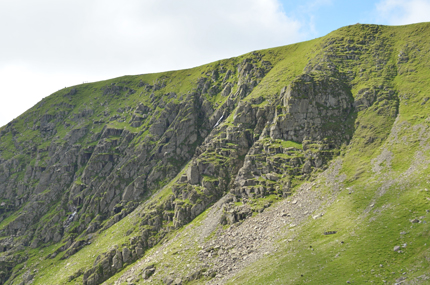 |
Helvellyn East Head Wall.
A slight suspicion tells me that the painting "The Precipice" by Francis Danby appears to look remarkably like the rock tower seen directly below the trig point on Helvellyn summit but these are just my humble thoughts, |
|
|
 |
The Precipice
Francis Danby 1827 |
|
 |
| Looking back up at Swirral Edge as I descend towards Red Tarn. |
| |
 |
| Striding Edge featuring The Chimney and The Castle seen towering above Red Tarn. |
| My exploration will see me take a look around below the col seen between The Chimney and The Castle. Apprehension begins to descend upon me as I am fully aware of the sensitivity surrounding this area below Striding Edge. |
 |
| Catstye Cam from Red Tarn. |
| |
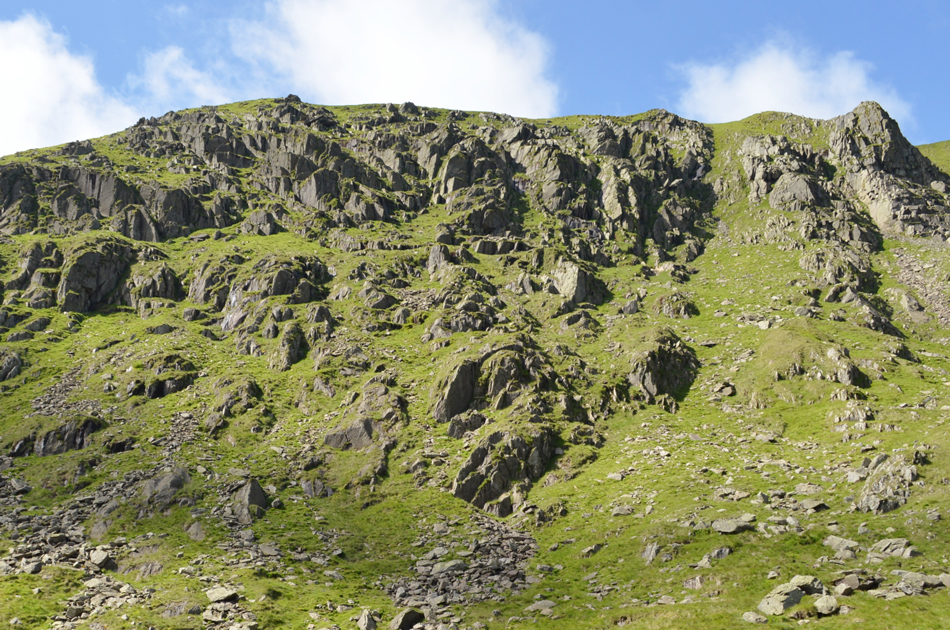 |
| Helvellyn Eastern Head Wall from Red Tarn. |
| |
 |
| Catstye Cam from Red Tarn. |
| |
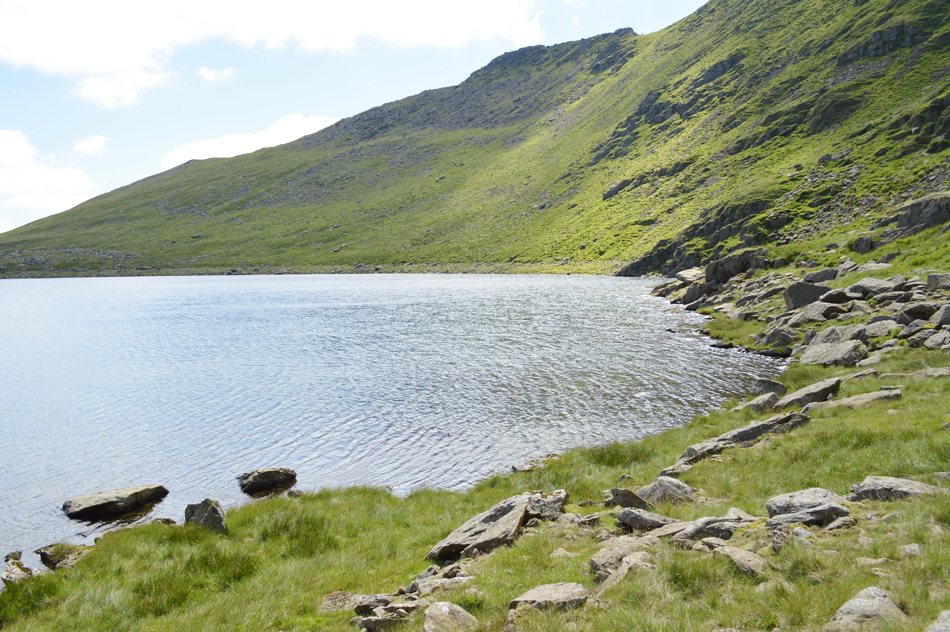 |
| Striding Edge from Red Tarn. |
| The mystery surrounding the death of Charles Gough was truly created when his faithful bitch Terrier dog Foxie was found alive at her masters side three months later after a local boy shepherd heard barking coming from Red Tarn, the young shepherd was still quite a distance away and followed the sound of the barking where he stumbled upon the bones of Charles Gough and his dog Foxie. |
 |
| The steep sided area directly below The Chimney. |
My heart began to palpitate within my chest, this is an area of incredible sensitivity and I knew I had to show the upmost respect for, I had been advised to have a look around this area and should I find something I should photograph it before informing the National Trust, it was with the rarest of possibilities that something would be found but I had to be instructed nonetheless. My main worry however, was not finding something from the past, but finding something new. |
 |
| Walkers on Striding Edge high above. |
| So close I can hear their every words. |
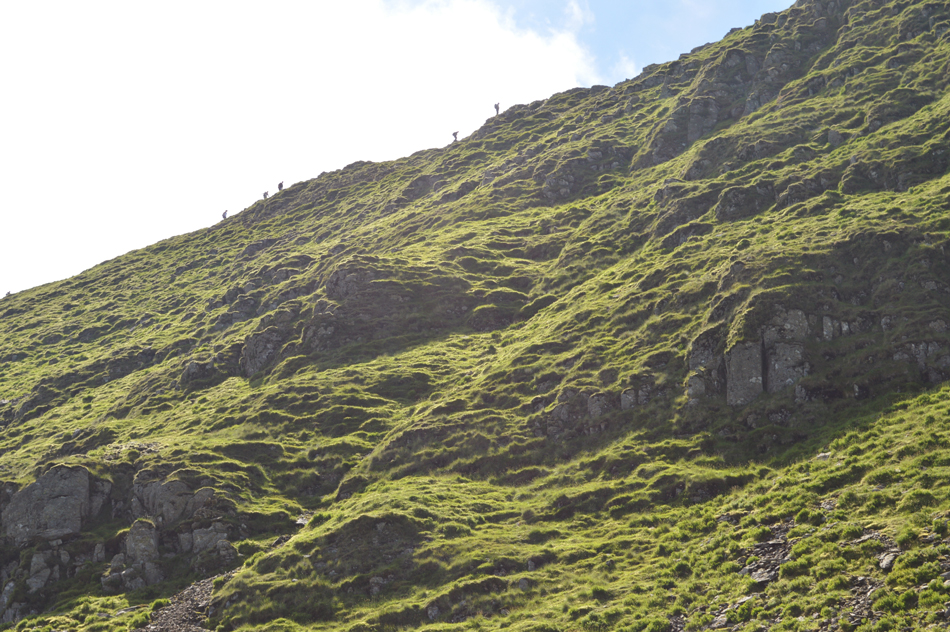 |
| Striding Edge. |
| |
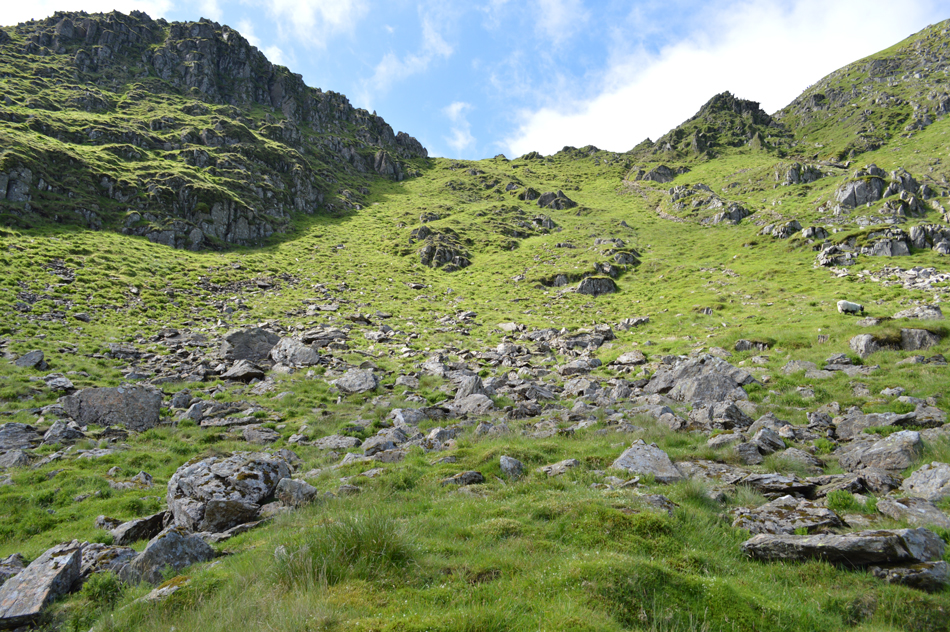 |
| The steep area of ground below The Chimney. |
I can only describe those next few moments of apprehension, yes of course I would have liked to found something, a piece of old cloth a cloak pin, anything but the chances of anything surviving the elements for over two hundred and twelve years was remote to say the least but I did find something.
I found a bloody dog lead!
Which is brings me onto the next chapter... |
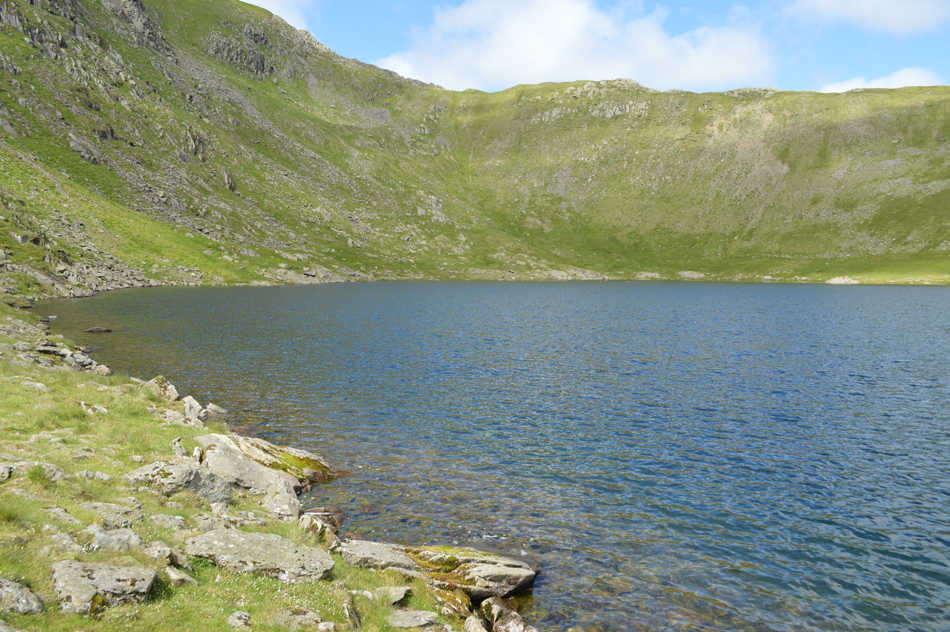 |
| Swirral Edge from Red Tarn. |
The body of Charles Gough was found on 22nd July 1805, alongside his bleached white bones beneath Gough's cloak his faithful dog Foxie still by his side. Controversy surrounds why Gough's bones had been stripped to bone and some may argue that Foxie had resorted to eating her master in order to stay alive but there are other myths that include a pack of Foxes devoured his body leaving the Raven's to strip the flesh completely from the bones. The idea that wild Foxes ate the flesh would seem a more likely possibility as some of his bones were left scattered including Gough's Skull which was found fifteen feet away from his body, Raven's cannot do this but a pack of Foxes will have no trouble tearing the bones from a rotting corpse.
Niver h'ard sec a thing spokken till, that t'laal dog ear t'master on 'im...It u'd hunger to deeath first
Words by Cannon H.D Rawnlsey resident of Wytheburn in the Story of Gough and his Dog 1891
But where was Foxie? The legend that made her master was found at the side of his bones three months later, incredibly she had whelped a pup which subsequently died but how did Foxie the Terrier survive at 2,400ft within the cusp of Spring in those exposed conditions? Myth has it that it was Foxie who tore the flesh from her master but I don't believe this to be true. The loyalty of a dog is unquestionable, one only has to ask the owner of one and with no-one else to take care of her I believe she fretted surviving on lambs (as it was Lambing season) rabbits, mice, grass and even slugs, fresh water was just a stones throw away however, the threat of death by exposure isn't so simple to explain, just how did she survive the brutalities of exposure at that altitude at that time of year.
I guess that's why Foxie, became the legend that she did, which then inspired the world famous poet William Wordsworth to write a poem about her and have it erected above where her master met his end. |
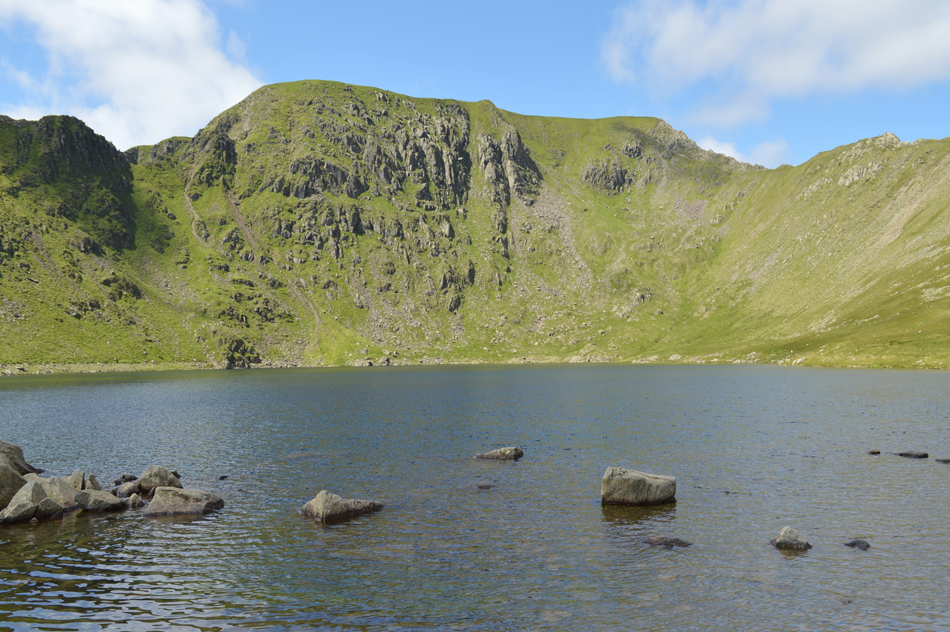 |
| Helvellyn and Swirral Edge from Red Tarn. |
| |
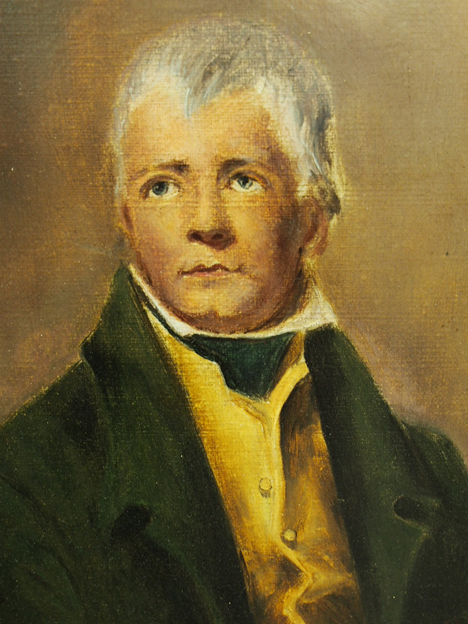 |
|
Helvellyn 1805
Sir Walter Scott
I climbed the dark brow of the mighty Helvellyn,
Lakes and mountains beneath me gleamed misty and wide;
All was still, save by fits, when the eagle was yelling,
And starting around me the echoes replied.
On the right, Striden-edge round the Red-tarn was bending,
And Catchedicam its left verge was defending,
One huge, nameless rock in the front was ascending,
When I marked the sad spot where the wanderer had died.
Dark green was that spot 'mid the brown mountain heather,
Where the pilgrim of nature lay stretched in decay,
Like the corpse of an outcast abandoned to weather,
Till the mountain-winds wasted the tenantless clay.
Nor yet quite deserted, though lonely extended,
For, faithful in death, his mute favourite attended,
The much-loved remains of her master defended,
And chased the hill-fox and the raven away.
How long didst thou think that his silence was slumber?
When the wind waved his garment, how oft didst thou start?
How many long days and long weeks didst thou number,
Ere he faded before thee, the friend of thy heart?
And, oh! was it meet, that—no requiem read o'er him,
No mother to weep, and no friend to deplore him,
And thou, little guardian, alone stretched before him—
Unhonoured the pilgrim from life should depart?
When a prince to the fate of the peasant has yielded,
The tapestry waves dark round the dim-lighted hall;
With scutcheons of silver the coffin is shielded,
And pages stand mute by the canopied pall;
Through the courts, at deep midnight, the torches are gleaming;
In the proudly arched chapel the banners are beaming;
Far adown the long aisle sacred music is streaming,
Lamenting a chief of the people should fall.
But meeter for thee, gentle lover of nature,
To lay down thy head like the meek mountain lamb,
When, wildered, he drops from some cliff huge in stature,
And draws his last sob by the side of his dam.
And more stately thy couch by this desert lake lying,
Thy obsequies sung by the gray plover flying,
With but one faithful friend to witness thy dying
In the arms of Helvellyn and Catchedicam.
|
 |
|
Fidelity 1807
William Wordsworth
A barking sound the Shepherd hears,
A cry as of a dog or fox;
He halts--and searches with his eyes
Among the scattered rocks:
And now at distance can discern
A stirring in a brake of fern;
And instantly a dog is seen,
Glancing through that covert green.
The Dog is not of mountain breed;
Its motions, too, are wild and shy;
With something, as the Shepherd thinks,
Unusual in its cry:
Nor is there any one in sight
All round, in hollow or on height;
Nor shout, nor whistle strikes his ear;
What is the creature doing here?
It was a cove, a huge recess,
That keeps, till June, December's snow;
A lofty precipice in front,
A silent tarn below!
Far in the bosom of Helvellyn,
Remote from public road or dwelling,
Pathway, or cultivated land;
From trace of human foot or hand.
There sometimes doth a leaping fish
Send through the tarn a lonely cheer;
The crags repeat the raven's croak,
In symphony austere;
Thither the rainbow comes--the cloud--
And mists that spread the flying shroud;
And sunbeams; and the sounding blast,
That, if it could, would hurry past;
But that enormous barrier holds it fast.
Not free from boding thoughts, a while
The Shepherd stood; then makes his way
O'er rocks and stones, following the Dog
As quickly as he may;
Nor far had gone before he found
A human skeleton on the ground;
The appalled Discoverer with a sigh
Looks round, to learn the history.
From those abrupt and perilous rocks
The Man had fallen, that place of fear!
At length upon the Shepherd's mind
It breaks, and all is clear:
He instantly recalled the name,
And who he was, and whence he came;
Remembered, too, the very day
On which the Traveller passed this way.
But hear a wonder, for whose sake
This lamentable tale I tell!
A lasting monument of words
This wonder merits well.
The Dog, which still was hovering nigh,
Repeating the same timid cry,
This Dog, had been through three months' space
A dweller in that savage place.
Yes, proof was plain that, since the day
When this ill-fated Traveller died,
The Dog had watched about the spot,
Or by his master's side:
How nourished here through such long time
He knows, who gave that love sublime;
And gave that strength of feeling, great
Above all human estimate! |
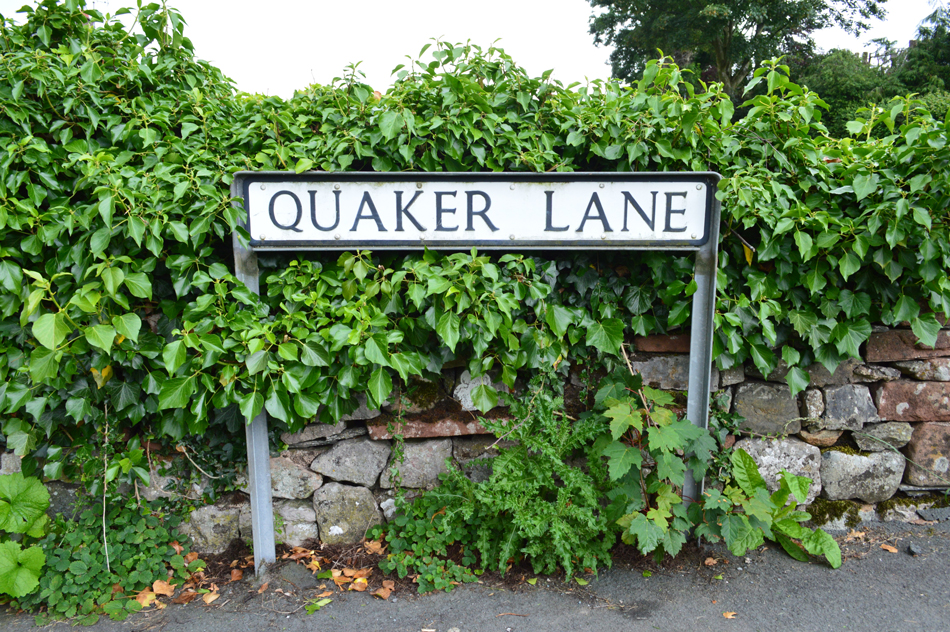 |
| Quaker Lane, Tirrel. |
The remains of Charles Gough along with his belongings which consisted of a fishing reel, a gold watch, a silver propelling pencil and two Claude glasses (a convex mirror used by landscape painters at the time) was carried back to Patterdale along with Foxie who was overjoyed and still in remarkably good health. Unfortunately Gough's Skull was not returned to Patterdale until it was ordered that someone go back and make the gruesome recovery where it was then deposited in the coffin along with his bones before being carried the fourteen miles to a Quakers burial ground in nearby Tirrel.
On Thursday 25th July 1805 Charles Gough was interred at an old Quakers burial ground before Mass at 9:30 that morning. |
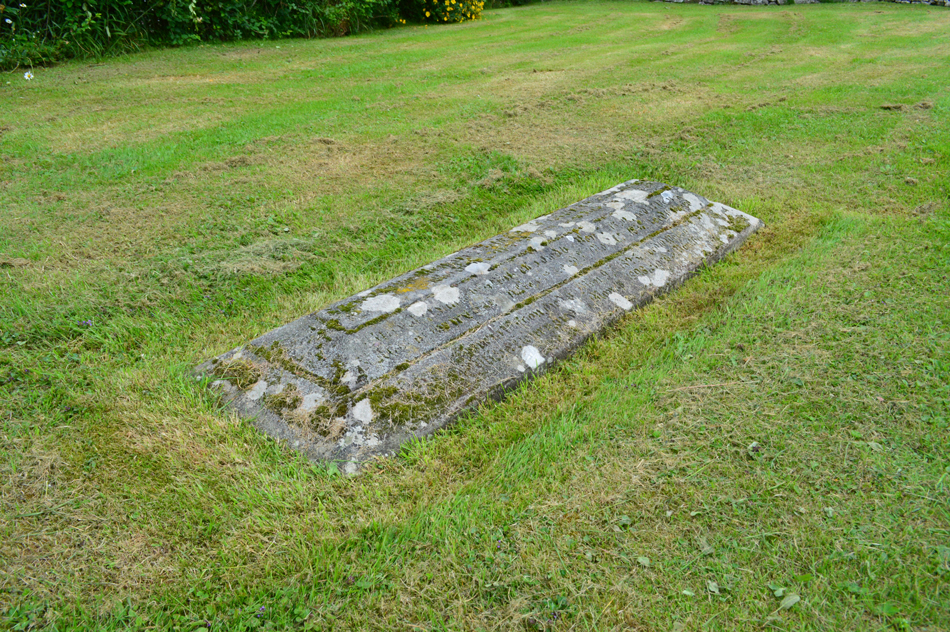 |
| The tomb of Charles Gough, Quakers Buriel Ground, Tirrel, Penrith. |
Later that day I arrived back in Patterdale after descending into the Grisedale valley under a hot afternoon sun, my research lead me to Tirrel and to the resting place of Charles Gough situated within the grounds of an old white washed cottage. Gough was only a young man when he died and could have gone on to be as successful as Wordsworth but instead he opened the door for the Victorians who traversed the Lakeland fells who consequently founded the National Trust.
That dreaded fear of death while pursuing the Lakeland fells may at one time or another pass through the walkers mind yet in this modern age that we live in this is greatly reduced thanks to Mountain Rescue, mapping and modern technology. When Charles Gough died on the mountain it took three months for his remains to be found due to the remoteness of his location but in truth he didn't die alone, he had his faithful dog Foxie who never left his side for three months suffering what the mountain threw at her until Gough and Foxie were finally found.
It is a point that can never be wholly cleared up
Benjamin Scott, Letter to Mary Carr 16th January 1889
|
|
| |
| Back to top |
 |
|
